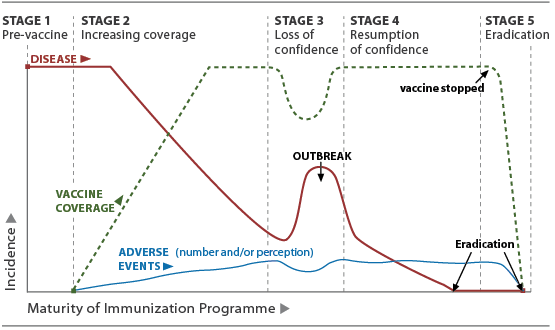Assessment 1
Question 5

An immunization programme can undergo several stages (Pre-vaccine, Increasing vaccination coverage, Loss of confidence, resumption of confidence, and eradication. Which of the following statements are correct?
Select one or more:
| A. Pre-vaccine (STAGE 1): No adverse events occur during the pre-vaccine stage. | |
| B. Increasing vaccination coverage (STAGE 2): The coverage of vaccination increase, the prevented disease’s incidence decreases, adverse events to the vaccine decrease. | |
| C. Loss of confidence (STAGE 3): The reduced appearance of the prevented illness and the increased focus on AEFIs, often intensified by media coverage lead to a loss of confidence in the vaccine by the public. This leads to a reduction in vaccine coverage, which leads to a resurgence of the disease to higher or even epidemic levels. | |
| D. Resumption of confidence (STAGE 4): Resurgence of disease and effective communication work by immunization programme officers lead to a regain in public acceptance of the vaccine. Vaccination levels have increased and the disease incidence decreases. | |
| E. Eradication (STAGE 5): Once a disease is eradicated, vaccine use can be stopped. |
Answers A, C, D and E are correct.
In the pre-vaccine era, morbidity and mortality caused by infectious diseases that are now preventable were high. Obviously, as vaccines did not exist, there were no adverse events to them yet. The pre-vaccine stage in the graph (STAGE 1) is the phase before the vaccine gets introduced.
STAGE 2, after an effective vaccine is introduced to prevent a particular disease, an increase in immunization uptake will result in a decrease in disease incidence, but also adverse events (AEFI), real or perceived, may become a major focus. Paradoxically, it is just when vaccine benefits are most apparent and vaccine coverage is highest that vaccine safety concerns are most likely to increase in the general public.
This increased focus on AEFIs, often intensified by media coverage of one or a few case reports, may lead to:
- A loss of confidence in the vaccine by the public,
- A reduction in vaccine coverage,
- A resurgence of the disease to higher or even epidemic levels (STAGE 3).
The resurgence of disease or the availability of an alternative vaccine results in renewed public acceptance of vaccination against the disease. Vaccination levels increase and the disease is reduced to earlier low levels (STAGE 4).
For vaccine-preventable diseases, such as smallpox, that have be eradicated, vaccine use can be stopped, thereby removing the risk of any adverse event resulting from its use (STAGE 5).
